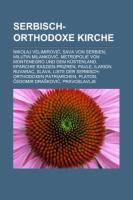- Start
- Serbisch-Orthodoxe Kirche
Serbisch-Orthodoxe Kirche
Angebote / Angebote:
Quelle: Wikipedia. Seiten: 103. Nicht dargestellt. Kapitel: Nikolaj Velimirovic, Sava Von Serbien, Milutin Milankovic, Metropolie Von Montenegro Und Dem Küstenland, Eparchie Raszien-Prizren, Pavle, Ilarion Ruvarac, Slava, Liste Der Serbisch-Orthodoxen Patriarchen, Platon, Cedomir DraSkovic, Pravoslavlje, Amfilohije Radovic, Irinej, Serbisch-Orthodoxe Kirche in Deutschland, Artemije Radosavljevic, Vasilije OstroSki, Arsenije Plamenac, Jelena stiljanovic, Anastasija Srpska, Makarije, Justin Popovic, Angelina Srpska, Stefan Der Serbe, Isaiah Der Serbe, Servikon, Konstantin Ðokic. Auszug: Milutin Milankovic (Serbian Cyrillic: ¿¿¿¿¿¿¿ ¿¿¿¿¿¿¿¿¿¿) (born in Dalj, Austria-Hungary on 28 May 1879, died Belgrade, Yugoslavia on 12 December 1958), was a Serbian geophysicist and civil engineer, best known for his theory of ice ages, suggesting a relationship between Earth's long-term climate changes and periodic changes in its orbit, now known as Milankovitch cycles. Born to Serbian parents in the village of Dalj, Austria-Hungary, Milutin Milankovic attended the Technische Hochschule in Vienna (today Vienna University of Technology) where he graduated in Civil Engineering in 1902 and earned a doctorate in technical sciences in 1904. Later he worked in the then-famous firm of Adolf Baron Pittel Betonbau-Unternehmung in Vienna. He built dams, bridges, viaducts, aqueducts and other structures in reinforced concrete throughout the Austria-Hungary of the time. Milankovic continued to practice civil engineering in Vienna until the autumn of 1909, when he was offered the chair of applied mathematics (rational mechanics, celestial mechanics, theoretical physics) in Belgrade. The year 1909 marked a turning-point in his life. Although he continued to pursue his investigations of various problems pertaining to the applications of reinforced concrete, he decided to concentrate on fundamental research. Milankovitch cyclesTurbulent events took place as soon as he had settled down in Belgrade, when the Balkan Wars were followed by World War I. When the war broke out in 1914 (he was just-married), he was interned by the Austro-Hungarian army in Neusiedl am See and later in Budapest, where he was allowed to work in the library of the Hungarian Academy of Sciences. As early as 1912, his interests turned to solar climates and temperatures prevailing on the planets. Throughout his internment in Budapest he devoted his time to this field and, by the end of the war, he had finished a monograph which was published in 1920, in the publications of the Serbian Academy of Sciences and A
Folgt in ca. 5 Arbeitstagen
